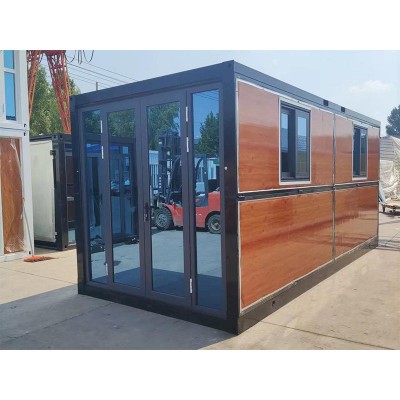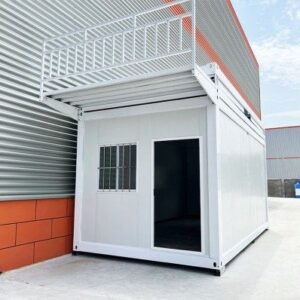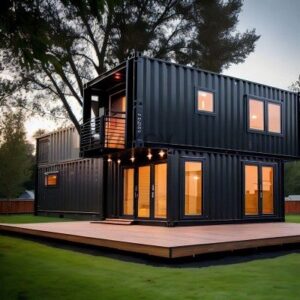How Much Does A Shipping Container House Cost Factors Influencing
When figuring out how much does a shipping container house cost, several key factors come into play that can significantly impact your overall budget.
Container Size and Quantity
- 20ft vs 40ft containers: Smaller 20ft containers are less expensive initially but offer less living space, while 40ft containers cost more but provide better room to work with.
- Single vs multiple units: One container is simpler and cheaper to convert, but combining multiple containers for larger homes drives up costs due to additional structural work and modifications.
Location and Land Costs
- Urban vs rural land: Building in urban areas usually means higher land prices and permit fees, while rural spots may be cheaper but could add costs for utility connections.
- Local permits and zoning regulations: Some areas have strict building codes for container homes that can increase approval times and fees, impacting your project timeline and budget.
Design Complexity and Customization
- Basic, straightforward container homes keep costs down, but custom designs with unusual shapes, extra openings, or second stories require more labor and materials.
- Adding features like large windows, rooftop decks, or built-in storage will also increase the price.
Insulation and Climate Considerations
- Proper insulation and weatherproofing are critical and vary by region. Colder climates demand thicker insulation and heating systems, while warmer areas might need ventilation and cooling solutions.
- The choice between spray foam, panel insulation, or other types affects both cost and energy efficiency.
Utility Connections
- Connecting to water, sewage, and electricity can be straightforward or costly depending on your land’s infrastructure.
- Remote or off-grid locations may require alternative systems like solar panels, septic tanks, or rainwater collection, which impact your original budget.
Labor Costs and DIY vs Hiring Professionals
- Hiring professionals ensures quality, code compliance, and usually faster completion but increases labor expenses.
- A DIY approach can save money but requires skills, time, and tools—and might add unforeseen costs if mistakes happen.
Finishings and Interior Features
- Interior elements like flooring, windows, kitchens, and bathrooms range widely in price based on quality and brand.
- More luxurious finishes and appliances drive costs up, while basic, functional setups keep prices manageable.
Understanding these factors helps you get a clearer picture of the shipping container house price breakdown and allows you to prioritize what fits best with your budget and vision.
Detailed Cost Breakdown of Shipping Container Houses
When figuring out the cost to build a shipping container house, understanding where expenses come from helps you plan better. Here’s a clear breakdown of the major components affecting the shipping container house cost breakdown.
Price of Purchasing Shipping Containers New vs Used
- New containers typically cost between $3,000 and $5,000 for a standard 20ft unit. New containers ensure the best structural integrity and are free from previous damages or hazardous materials.
- Used containers can be found for as low as $1,200 to $2,500, but they may require repairs and thorough inspections before use. Costs here can vary by region and condition.

Modifications and Fabrication Costs
Cutting openings for windows, doors, and skylights involves welding and reinforcing the container’s structure to maintain strength. This stage can be one of the biggest expenses, especially for:
- Multiple modifications or complex custom layouts
- Adding reinforcement to avoid compromising container durability
- Installing extra features like fold-out walls or expandable sections
Approximate cost: $2,000 to $10,000 depending on design complexity and labor.
Insulation and Weatherproofing
Shipping containers are metal boxes, so insulation is critical for comfort and energy efficiency. Options include spray foam, rigid panels, or blanket insulation.
- Insulation costs can range from $1,500 to $6,000
- Weatherproofing and sealing to prevent rust and leaks adds to expenses but protects the home long-term
Insulation choice depends on your climate and local energy codes.
Interior Construction and Finishes
Interior work includes framing walls, installing drywall or paneling, flooring, electrical wiring, plumbing, and fixtures. The finish quality greatly influences the total price:
- Budget finishes: basic flooring, minimal drywall, and simple fixtures can keep costs down
- Higher-end finishes: hardwood floors, custom cabinetry, premium lighting, and appliances push your costs higher
Interior construction generally runs from $10,000 to $40,000+ depending on size and quality.
Installation On Site Including Foundation and Permits
Proper site installation is essential. Foundations vary from concrete slabs to piers or blocks, tailored to the container’s size and local codes.
- Foundation and site prep can cost $3,000 to $10,000
- Permits and inspections vary by location; urban areas typically charge more and require detailed reviews
Planning for this early saves surprises.
Utilities and Off-Grid Options
Connecting water, sewage, and electricity affects your budget depending on proximity to services.
- Hookups for city utilities can cost between $5,000 and $15,000
- Off-grid alternatives like solar panels, septic tanks, and rainwater collection add upfront costs but reduce ongoing expenses
Furnishing and Appliances
Don’t forget the cost of furniture, kitchen appliances, bathroom fixtures, and other essentials. Depending on your style and needs:
- Basic furnishing might cost $5,000 to $15,000
- Custom or luxury setups will increase the budget significantly
What Is a Shipping Container House
A shipping container house is a home built by repurposing steel shipping containers as the primary structure. These containers are originally designed for transporting goods, but their size, shape, and strength make them ideal for creating modular, affordable living spaces. Container homes can be standalone units or combined to create larger multi-container layouts.
Advantages of Shipping Container Houses
There are several key benefits that make shipping container houses an attractive option:
- Durability: Made from corrosion-resistant steel, shipping containers are built to withstand harsh weather and heavy loads. This makes container homes strong, secure, and long-lasting.
- Modularity: Containers are standardized in size and shape, allowing easy stacking, combining, and customization to fit various layouts and designs.
- Sustainability: Using repurposed containers reduces waste and minimizes the environmental footprint compared to traditional construction materials. It also supports recycling and upcycling efforts.
- Affordability: Compared to conventional building methods, container homes can offer cost savings especially when using used containers or opting for DIY construction.
- Speed of Construction: Prefabricated and modular nature speeds up the building process, which can significantly reduce project timelines.
Typical Sizes and Types of Containers Used for Homes
Most shipping container houses use containers in standardized sizes:
- 20-foot containers: Approximately 160 square feet of floor space. These are easier to transport and handle but offer limited room individually.
- 40-foot containers: About 320 square feet of floor area. These are ideal for single larger units or combined for multi-container homes.
- High cube containers: Similar lengths but roughly a foot taller than standard containers, offering extra interior height.
- Bulkhead containers and refrigerated containers: Occasionally adapted for specialized spaces, though less common due to cost and conversion complexity.
Selecting the right type and number of containers depends on the desired size and design goals of the home. For example, combining multiple 20-foot containers can create multi-room layouts, while 40-foot containers can serve well for open-plan spaces.
Understanding these basic elements sets the foundation for exploring the cost of building a shipping container home and what factors influence pricing.
Typical Shipping Container House Cost Ranges and Examples
When considering how much does a shipping container house cost, it’s helpful to break it down into general price ranges based on size, features, and customization level. Here’s a straightforward look at typical costs you can expect:
Budget-Friendly Container Homes $10,000 to $30,000
- Usually built from used 20ft containers
- Minimal modifications, basic insulation, and simple finishes
- Often a single container or a small pod setup
- Suitable for temporary housing, studios, or guest houses
- Ideal for DIY projects or those with tight budgets
- Example: A basic 20ft container with simple wiring and insulation in a rural area
Mid-Range Container Homes $50,000 to $100,000
- Commonly use one or more 40ft containers or stacked units
- Moderate customization, better insulation, and upgraded finishes
- Includes essential utilities—plumbing, electricity, heating/cooling
- Can feature simple kitchens and bathrooms
- Suitable for full-time residences or vacation homes
- Example: Two connected 40ft containers with a modern kitchen, bathroom, and quality flooring in suburban areas
Luxury Custom Container Homes $150,000 and Up
- Multiple containers with complex architectural designs
- High-end materials, smart home tech, custom interiors
- Advanced insulation and energy-efficient systems
- Premium kitchen, bathrooms, and flooring
- Site prep, landscaping, and permits factored in
- Example: Multi-story container home in urban locations with designer details and full amenities
Regional Cost Variations
- Urban areas tend to have higher land and permit fees, pushing total costs up
- Rural locations generally lower land costs but may add expenses for utility hookups
- Climate can affect insulation and construction costs, especially in colder U.S. regions
- Labor rates vary widely by state, influencing the total price significantly
Comparing Shipping Container Houses to Traditional Homes Cost and Value
When weighing the cost of a shipping container home against a traditional house, there are clear pros and cons to consider.
Cost Advantages and Disadvantages
- Lower base costs: Shipping container houses often start cheaper than traditional homes, especially if you use used containers and simple designs. Basic container homes can range from $10,000 to $30,000, much less than traditional construction.
- Hidden costs: Modifications, insulation, utility setup, and permits can quickly add up. These extras mean your shipping container house price breakdown might sometimes approach the cost of a modest traditional home.
- Savings on labor: If you DIY parts of the build, you can significantly cut costs. But hiring professionals for complex modifications or high-end finishes pushes prices closer to traditional home budgets.
- Material reuse: Containers are durable and recyclable, which helps reduce long-term material costs compared to building entirely new foundations and framing.
Time to Build and Obtain Permits
- Faster build times: Container homes generally go up faster. The sturdy shell is already there, so construction mostly focuses on interior work and utilities.
- Permitting can vary: Getting permits depends heavily on your location. In some U.S. cities and counties, container homes face extra hurdles because they don’t fit typical building codes, potentially dragging out approval times. Urban areas tend to have stricter zoning and longer waits.
- Simplified modular design: Containers lend themselves to modular building, speeding things up in both construction and inspection stages.
Longevity and Maintenance Costs
- Durability: Shipping containers are built strong to handle cargo shipping, so they naturally offer good longevity. Steel structures resist pests like termites and won’t rot like wood framing.
- Maintenance: Rust protection and proper insulation are key. Without these, the steel shell can corrode over time, increasing upkeep costs. Traditional homes require periodic painting, roofing, and landscaping, which are ongoing costs.
- Energy efficiency: Container homes need effective insulation to maintain energy efficiency. This added expense can be higher than in traditional homes but pays off by reducing heating and cooling bills over time.
of Key Differences
| Aspect | Shipping Container Home | Traditional Home |
|---|---|---|
| Initial Cost | Generally lower base cost, variable with customization | Typically higher upfront construction cost |
| Permitting | Can be slower or more complex depending on location | More straightforward, widely accepted codes |
| Build Time | Faster, modular approach | Longer due to traditional construction methods |
| Durability | Strong steel shell, needs rust protection | Wood/brick prone to weather & pests, but well-understood upkeep |
| Maintenance | Requires rust proofing and insulation checks | Regular painting, roofing, landscaping |
| Energy Efficiency | Depends on insulation quality | Built-in from design, often better initially |
Understanding these factors helps you decide if the cost to build a shipping container house fits your budget and time frame, especially compared to a traditional build. It comes down to your priorities around budget, timeline, design freedom, and long-term maintenance.
Additional Financial Considerations for Shipping Container Houses
When thinking about how much does a shipping container house cost, it’s important to look beyond just the build price. Here are some key financial factors to keep in mind.
Financing Options and Availability
Getting a loan for a container home can be trickier than traditional houses. Many banks see container homes as unconventional, so:
- Loans may have higher interest rates or demand larger down payments
- You might consider personal loans, construction loans, or RV/mobile home financing if land is already owned
- Some specialty lenders focus on tiny homes and modular builds, which may cover container homes
- DIY builders often self-finance to avoid complex loan processes
Planning your budget with financing options in mind can save surprises later.
Potential Resale Value and Investment Perspective
When it comes to resale:
- Container homes usually hold value well in urban areas where modern, affordable housing is in demand
- Custom designs or multiple-container setups can increase market appeal
- However, resale value largely depends on local real estate trends and neighborhood acceptance
- Compared to traditional homes, container homes might have a niche market, so expect a potentially longer sale process but good returns on unique features
If you view your container house as an investment, factor in both appreciation potential and marketability.
Insurance Costs for Shipping Container Homes
Insurance is often overlooked but vital. For container homes:
- Some insurance providers treat them like conventional homes; others classify them closer to mobile or prefab homes
- Insurance premiums can vary based on location, build quality, and materials used
- Adding robust security and safety features may lower your insurance costs
- It’s essential to get quotes from multiple insurers familiar with container home risks
- Coverage usually includes protection against fire, weather damage, theft, and liability
Considering insurance early helps ensure you budget appropriately and protect your investment long-term.
How Yichen Can Help with Shipping Container House Costs and Construction
When it comes to building a shipping container house, Yichen offers comprehensive services covering every step from consultation to completion. Whether you’re looking for a simple 20ft container house or a custom multi-container home, Yichen’s team brings the expertise to guide you through design, permits, and construction efficiently.
Expert Consultation and Customized Design
Yichen starts by understanding your specific needs and budget. Their consultants help you:
- Choose the right container sizes and types based on your space and cost goals
- Navigate local permits and zoning requirements
- Opt for design features and insulation suited to your local climate
This personalized design approach helps avoid unnecessary expenses and ensures you get the best value.
Quality Construction with Cost Efficiency
Yichen combines modern fabrication techniques with sustainable, durable materials to build container homes that last. By managing everything from container modifications like cutting and welding to interior finishes and utilities, they keep costs transparent and under control. Their experience means fewer surprises during the build, saving you time and money.
Why Choose Yichen for Your Shipping Container Home
- End-to-end service: From buying containers to final inspections
- Cost-effective solutions without sacrificing quality
- Reliable project management to stay on schedule and within budget
- Local knowledge to adapt your container home perfectly for your U.S. location and climate
Get Your Personalized Shipping Container House Quote
Ready to start your affordable container home journey? Contact Yichen today for a personalized quote tailored to your needs and site conditions. Visit the contact page or reach out directly to discuss your container home project and receive expert advice on cost-saving options.
Building a container home shouldn’t be complicated or costly. Let Yichen make it simple, transparent, and affordable—so you can enjoy a durable, stylish, and sustainable living space without the guesswork



